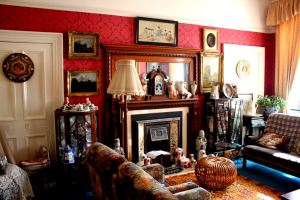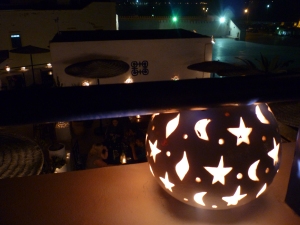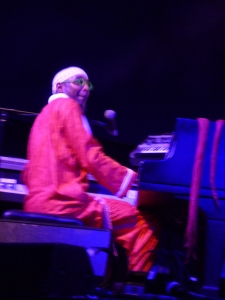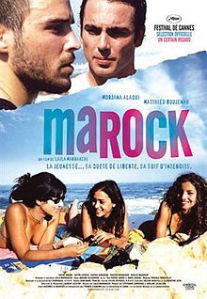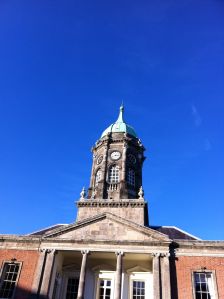
- blue skies over Dublin Castle
I was recently in Dublin for work and stayed on an extra night to visit a Dubliner friend. As I have been to Dublin before, instead of the usual sights, I took the opportunity to live a bit more like a local for a day, and test the shopping, eating and drinking options.
Dublin city centre isn’t very big and is manageable on foot. It’s easy to orientate yourself between the Liffey river and the triangle of Dublin Castle, Trinity college and St Stephen’s Green. All are worth a visit.
Shopping
Unlike many British city centres, there are still many independent stores in central Dublin. I was particularly intrigued by the fur and cigar shops – neither of which I felt the need to visit but both of which are absent from your average UK High Street. Grafton Street is home to the familiar international chains and designer outlets as well as home-grown Dunnes Stores, which is like an Irish BhS. More interesting are the shops in the streets parallel to Grafton Street (stretching back to South Great George St) and renovated buildings which have turned into multi-use spaces for more arty stores, event spaces and quirky cafes. Examples of these include Powerscourt on South William Street – a converted 18th century townhouse and courtyard – and George’s Street Arcade – a renovated Victorian covered market.

- A Christmas tree of macaroons at Cocoa Atelier
Despite some empty lots in the larger shopping streets and centres – obvious victims of the construction boom followed by the economic crash – niche artisan and independent shops seemed to be doing well. Some of the more interesting ones I spotted included A Rubanesque Ltd (in the Powerscourt centre and selling ribbons – one of many stores cashing in on the make do and mend trend); New Moon (beautiful locally designed plus imported jewellery in the George’s Street Arcade); Cocoa Atelier (on Drury Street with a beautiful macaroon display in the window); and Le Palais des Thés (a French tea boutique chain which I know from Brussels, on Wicklow Street).
Eating and Drinking
When I visited Dublin a number of years ago during the height of the boom, it was impossible to get a table in a restaurant without a reservation – for either of the two sittings a night. Economic circumstances being what they are, I was surprised we had to queue in a number of places, although the wait wasn’t long and reservations weren’t necessary. And the bars were just as full as ever. Here are the places we tried:

- veggie bento with nasu dengaku; asparagus futomaki; miso soup; brown rice; vegetable tempura; and roast red pepper, pumpkin & tofu salad,
Yamamori Noodles – a large Japanese-style restaurant with bench-style seating and offering a menu of pan Asian dishes. Despite the geographic breadth of the menu, the Japanese dishes were very tasty and authentic, although the portions were, if anything, rather large. This smacks of padding out a plate with cheaper ingredients in order to up the price, but I thought my (enormous) bento was good value, although the futomaki sushi was superfluous in addition to a bowl of (brown – most un-Japanese!) rice. They are obviously doing a lot of things right, as there is also an Oriental Café across the road and a Yamamori Sushi across the Liffey. Yamamori Noodles, 12-13 South Great George’s Street, Dublin 2. Tel: : (+353) (0)1 475 5001.

The Long Hall
The Long Hall –
a typical Victorian Dublin pub: packed to the rafters from which hang impressive chandeliers, a limited range of spirits (no fancy cocktails here), friendly staff and – I am told – an excellent pint of Guinness. You can’t move, but I am sure many Irish would caution against it with a pint in your hand anyway! The Lonely Planet calls it “elegantly dingy”. Getting out again was a long haul, but in Dublin bumping your way out of a pub only elicits multiple “Sorry”’s on all sides and smiles – it seems it’s all part of the craic! The Long Hall, 51 South St Georges St, Dublin 2. Tel: Tel: (+353) (0)1 475 1590.
Odessa – a modern restaurant plus lounge space and nightclub situated in a large townhouse, Odessa looks the part, down to the beautiful but snooty people employed there. The food is modern café/bistro style (and features no reference to the Black Sea, as far as I could tell!) with an eclectic weekend brunch menu. I had huevos rancheros, which were delicious – the guacamole was one of the best I’ve eaten – and a perfect (very) late breakfast after the night before. Odessa, 13-14 Dame Court, Dublin 2. Tel: (+353) (0)1 670 7634.
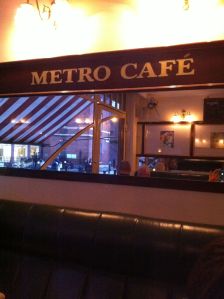
Metro Cafe
Metro Café – a French-style café with pavement tables, replica art nouveau wall lights and a jazz soundtrack. Offering a short menu of soups, sandwiches and cakes, it’s the perfect antidote to shopping-weariness. The staff are friendly and welcoming, although one is not encouraged to linger long. My chai tea latte was just the ticket after wandering the frosty Dublin streets! Metro Café, 43 South William St, Dublin 2. Tel: (+353) (0)1 679 4515
We tried to get into the Queen of Tarts café and patisserie in Cow’s Lane, an artsy steep street of cute cafes and retro shops which reminded me of Rue Fossé aux Loups (which is a foxes lane rather than a cow’s one!) in the Marolles in Brussels. However, it has clearly been in far too many in flight magazines and at lunchtime on Saturday the queue was out the door! Queen of Tarts, Cows Lane, Dame Street, Dublin 2. Tel: (+353) (0)1 633 4681

Bewley's tearoom
No trip to Dublin is complete without at least a cuppa in Bewley’s on Grafton Street – it’s an Irish institution. It harks back to a bygone era when all the major tea importers had tearooms on the High Street. Today it has a menu of lite bites such as sandwiches, pizza and pasta plus a huge range of irresistible cakes and pastries. It still retains an atmosphere of colonial times, with stained glass windows, wooden floors and enormous chandeliers. Bewley’s, 78/79 Grafton St, Dublin 2. Tel: (+353) (0)1 672 7720
Sights
I would definitely recommend the well-known tourist attractions (Trinity College, Dublin Castle, etc) but on this trip I enjoyed wandering through different neighbourhoods and seeing how people live. The Smithfield development, based around the Jameson Distillery, has seen (albeit brief) better times. It could be like Canary Wharf without the banks. Instead, it looks like a ghost town of failed dreams and vacant lots; the visible reminder of how dependent on the construction boom the Irish economy once was. Heading into town, we passed the wonderful red brick original fruit market, stuffed to the gills with onions.

Smithfield Fruit Market
We continued through a district where small shops and businesses run by recent immigrants to the erstwhile Celtic Tiger still seem to be getting by, despite more established brands falling on hard times. We also called in to the GPO on O’Connell St – still a post office and still with its old fashioned fixtures and fittings, despite the monumentous events which took place there at Easter in 1916.
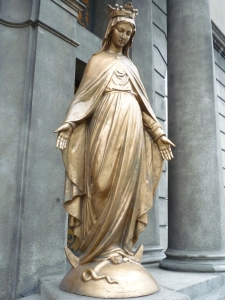
- Carmelite Church
In search of something to visit off the beaten tourist track (which, admittedly, normally leads to a pub in the Temple Bar area), we visited the Carmelite Church on Whitefriar Street. Although a mass was taking place, we were able to enter and see the Shrine of St Valentine, which contains a casket of his relics, a statue of the saint and an explanation of how his remains came to be in Ireland (a gift from the Holy See). In in the lobby there is an explanation of all the shrines in the church, including how 14 February, the day Valentine was martyred in (probably) 269 AD became a feast day. The day was previously a day on which Juno, the Roman goddess of women and marriage was celebrated, so the mutation of this day into one to celebrate Valentine’s martyrdom under Emperor Claudius II for practicing his Christian beliefs and marrying couples in secret seems an obvious one.
I am very grateful to Barbara and Joan for being such able tour guides and showing me the Dublin of Dubliners! Sláinte!
©Lynn Sheppard



